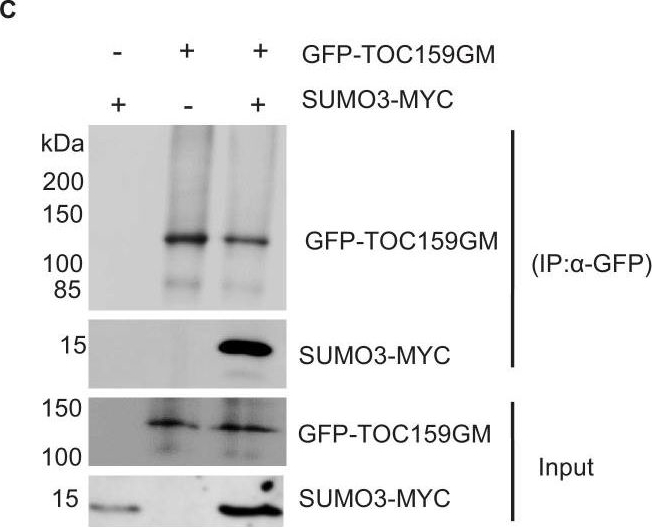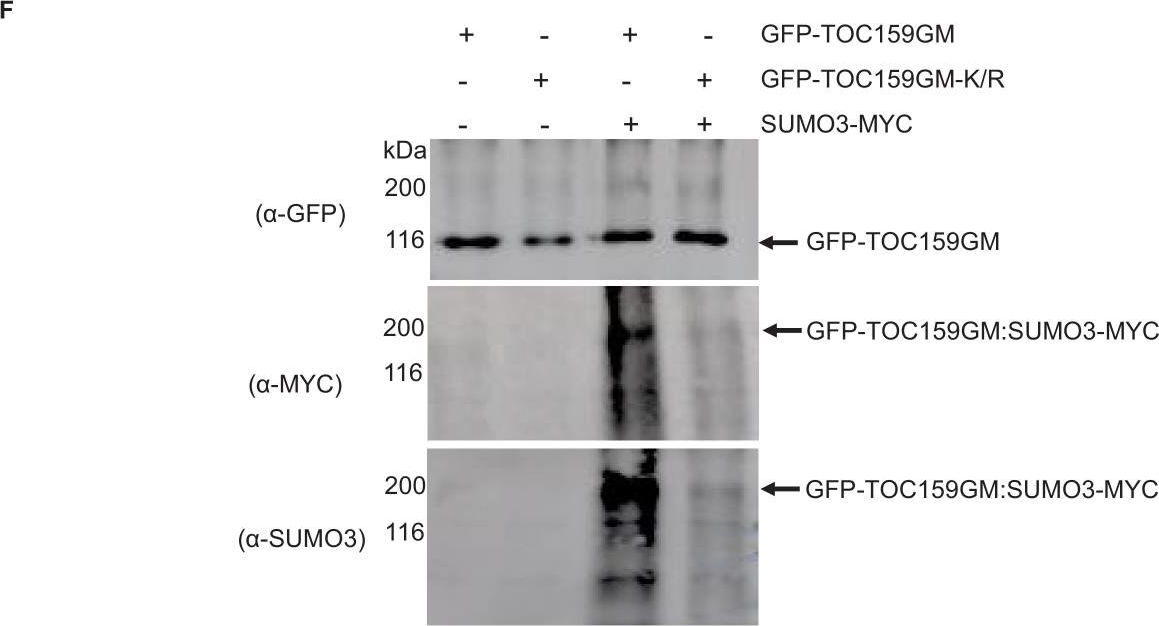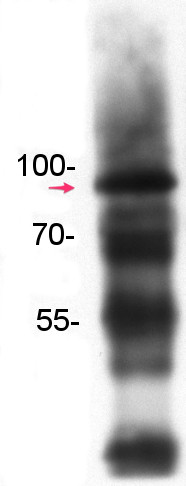1

SUMO3 | Small ubiquitin-like modifier protein 3 (peptide antibody)
AS08 349 | Clonality: Polyclonal | Host: Rabbit | Reactivity: Arabidopsis thaliana
- Product Info
-
Immunogen: KLH-conjugated peptide derived from SUMO3 sequence of Arabidopsis thaliana, UniProt: Q9FLP5, TAIR: AT5G55170
Host: Rabbit Clonality: Polyclonal Purity: Immunogen affinity purified serum in PBS pH 7.4. Format: Lyophilized Quantity: 50 µg Reconstitution: For reconstitution add 50 µl of sterile water Storage: Store lyophilized/reconstituted at -20°C; once reconstituted make aliquots to avoid repeated freeze-thaw cycles. Please remember to spin the tubes briefly prior to opening them to avoid any losses that might occur from material adhering to the cap or sides of the tube. Tested applications: Western blot (WB) Recommended dilution: 1 : 5000 for detection of recombinant SUMO3 (WB) - Reactivity
-
Confirmed reactivity: Arabidopsis thaliana Not reactive in: No confirmed exceptions from predicted reactivity are currently known - Application Examples
-
Application example
Protein, tagged with a 6xhis-tag, was expressed from a strain of E. coli that reconstituted the sumoylation system with SUMO3 (described in Elrouby et al). Cells were harvested and lysated by sonication in buffer containing 6M urea. Proteins were used to load a Nickel column under denaturing conditions with buffers containing 6M urea. A pH gradient was applied to release the specifically bound proteins and 0.5 ml aliquots were collected. The presence of the desired protein in each aliquot was checked in SDS-PAGE by Comassie staining. 3 ul of the aliquot showing the most intense signal were separated on 10% SDS-PAGE and blotted 1h to PVDF using tank transfer. Blots were blocked with TBS-T (0.1%) and 5% dry-milk powder for 4 h at room temperature (RT) with agitation. Blot was incubated in the primary antibody at a dilution of 1: 5000 overnight at 4ºC with agitation. The antibody solution was decanted and the blot was rinsed 4 times for 15 min in TBS-T (0.25%) at RT with agitation. Blot was incubated in secondary antibody (anti-rabbit IgG horse radish peroxidase conjugated, AS09 602 from Agrisera ) diluted to 1:50 000 in TBS-T (0.1%) and 5% dry-milk powder for 1h at RT with agitation. The blot was washed as above and developed for 5 min with chemiluminescent detection reagent, according to the manufacturer's instructions. Exposure time was 15 second.
Courtesy of Dr. Concepción Almoguera, CSIC, SpainApplication examples: 
Reactant: Arabidopsis thaliana (Thale cress)
Application: Western Blotting
Pudmed ID: 33350382
Journal: Elife
Figure Number: 1C
Published Date: 2020-12-22
First Author: Accossato, S.
Impact Factor: 7.937
Open PublicationSmall ubiquitin-related modifier (SUMO) interaction and SUMOylation of TOC159GM.(A) Schematic representation of TOC159GM indicating the predicted SUMO-interacting motif (SIM) in the G-domain. (B) Yeast two-hybrid interaction assay of TOC159 G with SUMO proteins on –Leu, –Trp and –Leu, –Trp, –His medium. AD, activation domain; BD, binding domain. (C) Transient expression of SUMO3-MYC, GFP-TOC159GM, and the combination of both in Nicotiana benthamiana leaves. Total protein extracts were subjected to immunoprecipitation with anti-GFP beads. The immunoprecipitated proteins from the expression of SUMO3-MYC (lane 1) and GFP-TOC159GM (lane 2) alone and the co-expression both (lane 3) were analyzed by western blotting using anti-GFP and anti-MYC antibodies. (D) Schematic representation of TOC159GM with indication of the predicted SUMOylation site K1370 (Lysine) at the M-domain. (E) Alignment of the conserved predicted K1370 SUMOylation sites in the M-domain of multiple species: Arabidopsis thaliana (At), Pisum sativum (Ps), Solanum lycopersicum (Sl), Oryza sativa (Os), and Sorghum bicolor (Sb) by using CLUSTAL Omega (1.2.4) multiple sequence alignment tool. (F) Transient expression of GFP-TOC159GM and GFP-TOC159GM-K/R (SUMO mutant, K1370 replaced with R) with and without SUMO3-MYC in N. benthamiana leaves. Total protein extracts were subjected to immunoprecipitation with anti-GFP beads. The immunoprecipitated proteins from the expression of GFP-TOC159GM (lane 1) and GFP-TOC159GM-K/R (lane 2) alone as well as the co-expression with SUMO3 (lanes 3 and 4) were analyzed by western blotting using anti-GFP, anti-MYC and anti-SUMO3 antibodies.Figure 1—source data 1.Source data for Figure 1E.Source data for Figure 1E.Yeast two-hybrid interaction assay of TOC159 M-domain with SUMO proteins on –Leu, –Trp and –Leu, –Trp, and –His medium.AD, activation domain; BD, binding domain; empty vector was used as a control.Predicted SUMOylation sites at TOC159GM and in planta SUMOylation assay.(A) Predicted SUMOylation sites at TOC159GM domain using the GPS-SUMO prediction algorithm with a high threshold (http://sumosp.biocuckoo.org/online.php). (B) Transient expression of GFP, GFP-TOC159GM, and GFP-TOC159GM-K/R (SUMO mutant, K1370 replaced with R) with SUMO3-MYC in Nicotiana benthamiana leaves. Total protein extracts were subjected to immunoprecipitation with anti-GFP beads. The immunoprecipitated proteins from the expression of GFP (lane 1), GFP-TOC159GM (lane 2), and GFP-TOC159GM-K/R (lane 3) co-expression with SUMO3 were analyzed by western blotting using anti-GFP and anti-MYC antibodies.

Reactant: Arabidopsis thaliana (Thale cress)
Application: Western Blotting
Pudmed ID: 33350382
Journal: Elife
Figure Number: 1F
Published Date: 2020-12-22
First Author: Accossato, S.
Impact Factor: 7.937
Open PublicationSmall ubiquitin-related modifier (SUMO) interaction and SUMOylation of TOC159GM.(A) Schematic representation of TOC159GM indicating the predicted SUMO-interacting motif (SIM) in the G-domain. (B) Yeast two-hybrid interaction assay of TOC159 G with SUMO proteins on –Leu, –Trp and –Leu, –Trp, –His medium. AD, activation domain; BD, binding domain. (C) Transient expression of SUMO3-MYC, GFP-TOC159GM, and the combination of both in Nicotiana benthamiana leaves. Total protein extracts were subjected to immunoprecipitation with anti-GFP beads. The immunoprecipitated proteins from the expression of SUMO3-MYC (lane 1) and GFP-TOC159GM (lane 2) alone and the co-expression both (lane 3) were analyzed by western blotting using anti-GFP and anti-MYC antibodies. (D) Schematic representation of TOC159GM with indication of the predicted SUMOylation site K1370 (Lysine) at the M-domain. (E) Alignment of the conserved predicted K1370 SUMOylation sites in the M-domain of multiple species: Arabidopsis thaliana (At), Pisum sativum (Ps), Solanum lycopersicum (Sl), Oryza sativa (Os), and Sorghum bicolor (Sb) by using CLUSTAL Omega (1.2.4) multiple sequence alignment tool. (F) Transient expression of GFP-TOC159GM and GFP-TOC159GM-K/R (SUMO mutant, K1370 replaced with R) with and without SUMO3-MYC in N. benthamiana leaves. Total protein extracts were subjected to immunoprecipitation with anti-GFP beads. The immunoprecipitated proteins from the expression of GFP-TOC159GM (lane 1) and GFP-TOC159GM-K/R (lane 2) alone as well as the co-expression with SUMO3 (lanes 3 and 4) were analyzed by western blotting using anti-GFP, anti-MYC and anti-SUMO3 antibodies.Figure 1—source data 1.Source data for Figure 1E.Source data for Figure 1E.Yeast two-hybrid interaction assay of TOC159 M-domain with SUMO proteins on –Leu, –Trp and –Leu, –Trp, and –His medium.AD, activation domain; BD, binding domain; empty vector was used as a control.Predicted SUMOylation sites at TOC159GM and in planta SUMOylation assay.(A) Predicted SUMOylation sites at TOC159GM domain using the GPS-SUMO prediction algorithm with a high threshold (http://sumosp.biocuckoo.org/online.php). (B) Transient expression of GFP, GFP-TOC159GM, and GFP-TOC159GM-K/R (SUMO mutant, K1370 replaced with R) with SUMO3-MYC in Nicotiana benthamiana leaves. Total protein extracts were subjected to immunoprecipitation with anti-GFP beads. The immunoprecipitated proteins from the expression of GFP (lane 1), GFP-TOC159GM (lane 2), and GFP-TOC159GM-K/R (lane 3) co-expression with SUMO3 were analyzed by western blotting using anti-GFP and anti-MYC antibodies.
- Additional Information
-
Additional information (application): The antibody is recognizing recombinant SUMO3 and shows no cross reactivity to SUMO1/2 - Background
-
Background: SUMO3 (Small ubiquitin-related modifier 3) is a small polypeptide that becomes covalently attached to various intracellular proteins leading to their post-translational modification. - Product Citations
-
Selected references: Saleh et al. (2015). Posttranslational Modifications of the Master Transcriptional Regulator NPR1 Enable Dynamic but Tight Control of Plant Immune Responses. Cell Host Microbe. 2015 Aug 12;18(2):169-82. doi: 10.1016/j.chom.2015.07.005. Saleh et al. (2015). Posttranslational Modifications of the Master Transcriptional Regulator NPR1 Enable Dynamic but Tight Control of Plant Immune Responses. Cell Host Microbe. 2015 Aug 12;18(2):169-82. doi: 10.1016/j.chom.2015.07.005.
- Protocols
-
Agrisera Western Blot protocol and video tutorials
- Reviews:
-
This product doesn't have any reviews.



